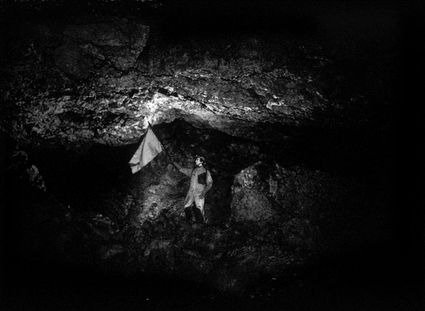Jasmina Cibic
dal 8/11/2012 al 30/11/2012
Segnalato da
8/11/2012
Jasmina Cibic
Skuc Gallery, Ljubljana
Situation Anophthalmus Hitleri. Cibic investigates two key moments within the construction and survival of national icons and their myths. The project begins with the story of the discovery of one of Slovenia's endemic species, Anophthalmus hitleri, a cave beetle.

Jasmina Cibic’s projects are conceived as a type of gesamtkunstwerk,
embracing variations of delegated performance and delegated object-
making, combining works by specialist practitioners such as architects
and scientists, as well as factories and craftsmen, chosen for their
historical and contextual relevance.
In her new project, Cibic investigates two key moments within the
construction and survival of national icons and their myths, namely
their invention and the chosen (architectonic) dispositive that
channels their perception by the spectator.
The artist conceived this project for the city of Maribor during its
year as European Capital of Culture specifically for its main
underground exhibition space. As is often the case with such events,
countries are compelled to present local specificities and ethnic
diversities as both unique and benign. Focusing on various historic
moments and their part in national myth making and its presentation,
Cibic critiques the drive toward new assemblages of critically devoid
faux icons of national export, where historical baggage and nouvelle
cultural identity constructions are far from resolved.
The project begins with the story of the discovery of one of
Slovenia’s endemic species, Anophthalmus hitleri, a cave beetle which
has recently entered the endangered species list solely because of its
name. Discovered in 1933 and named by an admirer of Hitler in 1937,
this blind beetle marks an un-erasable ideological moment as,
according to the rules of Linnaean taxonomy, animal and plant names
cannot be changed.
In 2006, National Geographic magazine published an article on the
insect and, soon after, prices for hitleri began to soar, resulting in
this small blind creature coming close to extinction.
Cibic has worked with over forty international entomologists and
scientific illustrators, including associates of The Natural Museum in
London, the US Department of Agriculture, the Zoological Museum at Tel
Aviv University, and others, who produced illustrations of the hitleri
beetle. The artist instructed the scientists to base their work solely
on their experience in entomology and their interpretation of the
beetle’s Latin name, without consulting any visual or descriptive
reference. The final works will be presented as an integral part of
Cibic’s underground installation as an encyclopedic-like display.
Situation Anophthalmus hitleri forms an installation environment where
actual hitleri beetles are presented within a series of models of the
modernist pavilions for trade fairs designed by Vinko Glanz, the chief
protocol architect of post-war Yugoslavia. The models were realised in
crystal by the Slovene company Rogaška, from the historical archives
of their product moulds. This company has been a major producer of
national souvenirs and protocol gifts for decades and is one of the
few that managed to survive the various political systems in this
country.
Glanz was the chosen government protocol architect in former
Yugoslavia and as such, an architect who realised most of the
‘translations’ of the architecture of previous regimes in the
country. His renovation and rebuilding projects included Tito’s
residences in Bled (Vila Bled) and on the Brioni Islands, The
People’s Assembly (today the Slovene Parliament) and Grad Brdo, the
government’s main venue for diplomatic meetings. Because of the
nature of his work, Glanz remained practically unpublished and very
little of his work is to be found in the state archives.
A few years ago, various plans and texts were discovered among his
legacy, including a stenographic record of the Committee for the
Review of Artistic Works and Sculptures in the new palace of the
National Assembly, which he built in post-war Ljubljana. The
transcript is of a discussion between politicians and art historians
who, together with the architect, debate which artists should be
chosen to carry out the mosaics, frescoes and sculptures on the portal
of the building, that were to represent the nation.
The transcript is the basis for a film script which Cibic wrote with
Ken Pratt, an essayist and curator of contemporary art, and Brian
Fillis, a British scriptwriter whose work includes drama and film
scripts for Channel 4, the BBC and others. Filming took place at Vila
Bled on exactly the same date as the aforementioned political debate
on art and architecture began 55 years ago. The short film will be
projected within the installation, presenting the unresolved dialogue
between art and architecture and questioning their mutual implications
within the formation of national iconography that is echoed in our
contemporary condition.
Slovenian-born, London-based artist Jasmina Cibic (b.1979) received
her MA in Fine Art at Goldsmiths College in London (2006). Her
projects and exhibitions include "The Ambassadors", Borderline,
Joanneums Museum Graz; “Bus-Tops”, a London 2012 Cultural Olympiad
project, London; “The Object of the Spectacle”, Galerija Škuc,
Ljubljana; “U3 – 6TH Triennial of Contemporary Art”, curated by
Charles Esche, Museum of Modern Art Ljubljana; “The Secret of the
Ninth Planet”, California College of the Arts, San Francisco;
“Museum on the Street”, Museum of Modern Art Ljubljana; “Percorsi
d’Arte”, Museum of Modern Art, Bologna; “Other Mythologies”,
Maribor Art Gallery, Maribor; “Present State”, Five Years Gallery,
London; “Tourists Welcome”, Ljubljana International Airport and
“Landescape”, Künstlerhaus Graz. She is the recipient of many
prestigious awards including Bevilacqua la Masa (Venice 2002, 2005)
and Trend Award for outstanding achievements in visual art in Slovenia.
Opening: 9 November 6pm - 9pm
Skuc Gallery
Stari trg 21- Ljubljana
Hours: Mon-Fri 9am-7pm
Free admission



